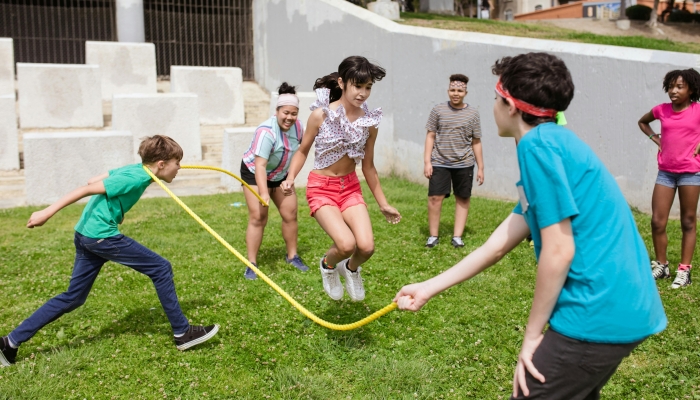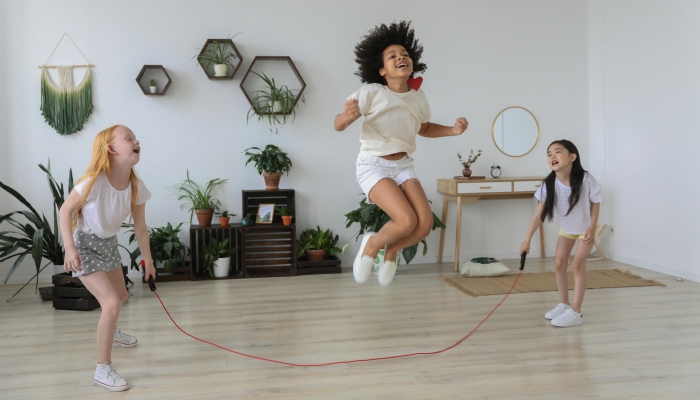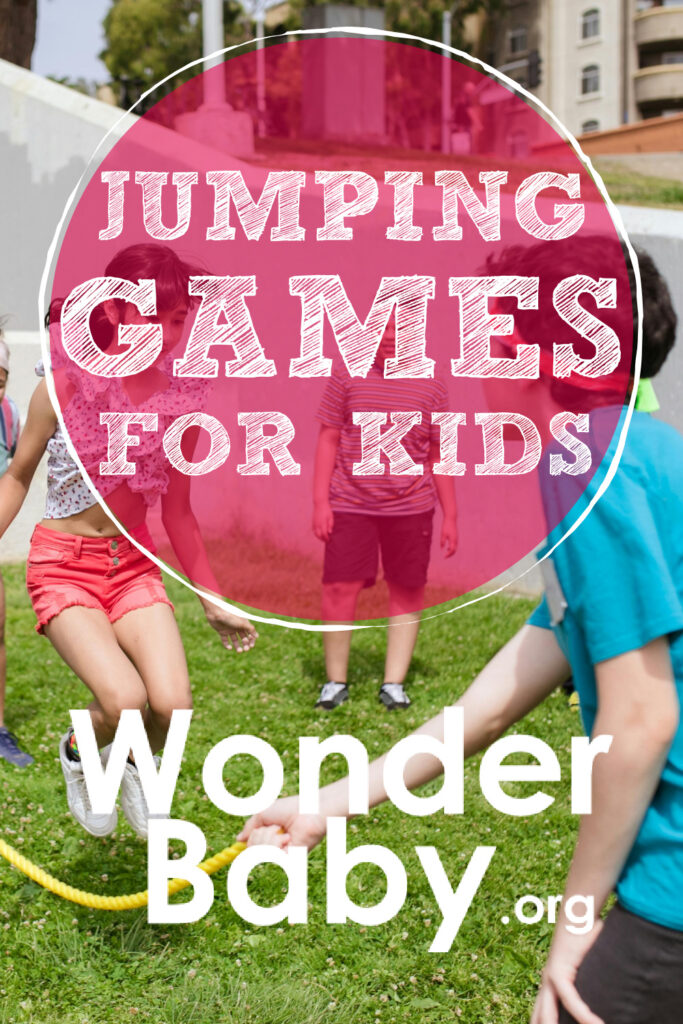4 Jumping Games for Kids

- Jumping games help kids improve their motor skills and physical fitness and keep them active through play.
- Hopscotch, leapfrog, and obstacle courses with jumping elements encourage creativity.
- Jumping games can be educational if you incorporate learning elements such as math or spelling.
Jumping games for kids are incredibly fun and also help improve coordination, balance, and physical fitness. If you want to keep your children active through play, these games are a great choice.
Whether you choose a classic jump rope challenge, get creative with hopscotch variations, or let your kids take the lead and create their own game, jumping is a fun way to channel boundless energy into healthy activity.
Plus, these games can be enjoyed by kids of all ages, making them ideal for family gatherings and playdates.
1. Hopscotch: The Classic Game with a Twist

You can play hopscotch almost anywhere, but pavements, concrete, or a sturdy indoor floor are the best surfaces.
Ask your kids to put on comfortable shoes with good grip before you start. This will prevent slipping.
You should also clear the play area of any obstacles and hazards your little ones can bump into if they lose their balance.
If you’re indoors, consider using foam hopscotch mats to avoid damaging your floors.
How To Play
Traditionally, hopscotch starts with drawing a grid of numbered squares on the ground. You can mark the hopscotch grid with chalk or tape, ensuring the lines are visible and evenly spaced.
- Throw a small object, such as a stone, onto square number one.
- Your child should hop on one foot through the squares, skipping the one with the object and retrieving it on their way back.
To add a fun twist and incorporate learning elements, try these variations:
- Math Hopscotch: Write simple math problems in the squares instead of numbers. Ask your kids to solve the problem before hopping to the next square.
- Spelling Hopscotch: Write letters in the squares and challenge your children to spell words as they hop through the grid.
- Geography Hopscotch: Draw a map on the ground with different countries or states in each square. As your kids hop, they can call out the name of the place they land on and share a fun fact about it.
With these and other variations, you can customize hopscotch to your child’s interests and educational needs while seamlessly blending fun and learning.
2. Jump Rope: From Solo to Group Challenges

Jump rope is a workout activity your kids can do in almost any open space. Besides being fun, it also improves fitness, rhythm, coordination, and other motor skills.
Research shows11. Yang, X., Lee, J., Gu, X., Zhang, X., & Zhang, T.. Physical Fitness Promotion among Adolescents: Effects of a Jump Rope-Based Physical Activity Afterschool Program. Children. 2020;7(8), 95. https://doi.org/10.3390/children7080095 that regular practice will help your child develop stronger muscles, improve flexibility and balance, and boost overall agility.
How To Play
Jump rope can be a solo or group activity. Here are some basic techniques and introductory tricks to teach your little ones:
Basic Techniques:
- Basic Single Bounce: Jump with both feet together over the rope. Try to keep a steady rhythm and bounce lightly.
- Double Bounce: Do a double bounce by jumping twice for each rope swing. This technique is excellent for beginners to find their rhythm.
- Alternate Foot Jump: Jump with one foot and then the other, as if jogging in place. This technique helps improve coordination and is a bit more challenging than a single bounce.
For each of these bounces, your child should start with the rope behind their back at their feet and swing it over their head.
Introductory Tricks:
After mastering the basic techniques, you could teach your child these tricks:
- Criss-Cross: Let your little one cross their arms in front of them while the rope is in the air above their head, and then uncross it for the next jump. This trick adds a fun twist and challenges coordination.
- Side Swing: Your child should swing the rope to one side of their body and jump over it, then swing it to the other side and jump again. This trick helps improve timing and agility.
- Backward Jumping: Instead of swinging the rope forward, ask your child to swing it backward and jump over it. This variation can be a fun challenge and works different muscles.
Jump rope can also be a fantastic group activity. Two kids can turn the rope while a third jumps in the middle, or you can form a line and take turns jumping.
3. Leapfrog: A Game of Coordination and Teamwork

Leapfrog is fantastic for building social skills such as turn-taking and communication. This classic game also encourages cooperation, as kids need to work together to succeed.
How To Play
- Setup: Gather a group of kids and find a spacious, obstacle-free area. Ask one child to crouch in a small “frog” shape on the ground.
- Leaping: Ask the next child in line to take a few steps back, run towards the crouching child, and place their hands on the “frog’s” back while leaping over them. After jumping, the leaping child crouches down a few feet in front of the first child.
- Turn-Taking: Ask the first child to stand up, run, and leap over the second child before crouching down again.
This process continues, with each child leaping over the others and crouching down.
You can also adjust the game for different skill levels. Here’s how:
- Start with smaller groups and a shorter distance for younger children or first-time players. Encourage gentle jumps and make sure everyone understands when it’s their turn.
- Make the game more challenging for older or experienced kids by increasing the distance between each “frog.” You can also ask them to hop on one foot or add a small obstacle to leap over.
4. Obstacle Course Jumping: Adventure and Agility

Obstacles courses improve agility and problem-solving skills while keeping children entertained and active. This is how you can include jumping elements:
How To Play
- Jumping Hurdles: Set up low hurdles using pool noodles, cones, or even sticks your kids have to jump over. Vary the height and distance to make it more challenging.
- Hula Hoop Jumps: Lay out hula hoops in different patterns on the ground. Tell your children to jump from hoop to hoop without stepping outside.
- Balancing Beams: Use a long piece of wood or a taped line on the floor as a balance beam. Ask your kids to jump on and off the beam at different points.
- Tire Hops: If you have old tires, arrange them in a pattern and tell your little ones to hop from one to the next.
- Cushion Mountains: Stack couch cushions or pillows to create a soft, bouncy area where your children can practice big jumps and soft landings.
Adapting Setups for Different Environments:
- If you’re indoors with limited space, use pillows, stuffed animals, and chairs to create obstacles. You can also use tape to mark paths and jumping spots on the floor.
- Natural elements like rocks, logs, and slopes work great if you can play outdoors. If you want more structure, you can use cones, ropes, and mats.
- Safe garden tools, lawn furniture, and toys can also help create a more diverse and engaging obstacle course.
Try to get creative with what you have!
Jumping Games Keep Kids Active
Children need physical activity to improve their motor skills and overall fitness, but asking them to hit the gym five times a week is unrealistic. Getting them to play a jumping game is not.
By incorporating jumping games into your children’s routine, you’re providing them with fun and helping them learn to enjoy exercise.
So, the next time your kids are bursting with energy, suggest one of these games. It’ll be even more fun if you join them!
References
- Yang, X., Lee, J., Gu, X., Zhang, X., & Zhang, T. (2020). Physical Fitness Promotion among Adolescents: Effects of a Jump Rope-Based Physical Activity Afterschool Program. Children, 7(8), 95. https://doi.org/10.3390/children7080095

Related Posts

Fine and Gross Motor
5 Alternatives to Tummy Time for Babies with Motor Development Challenges
Does your baby struggle with tummy time due to motor development challenges? These alternatives to tummy time will offer the same benefits.

Fine and Gross Motor
Understanding Hypotonia & Hypertonia: What Parents Need to Know
Altered muscle tone can affect your child’s development. Learn more about ways you can help your child by understanding hypertonia and hypotonia.

Fine and Gross Motor
4 Static Balance Activities for Kids
These four fun exercises will boost your child's static balance and coordination. They improve postural balance and strengthen core and glute muscles.